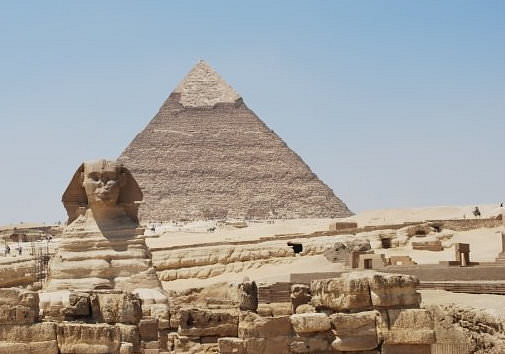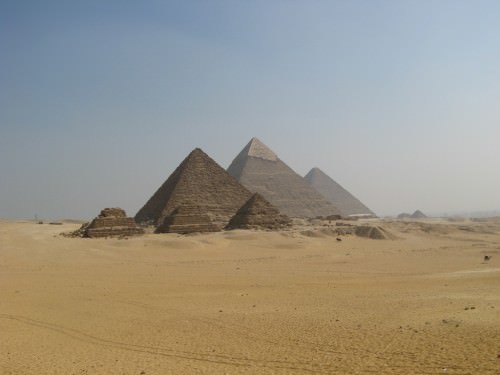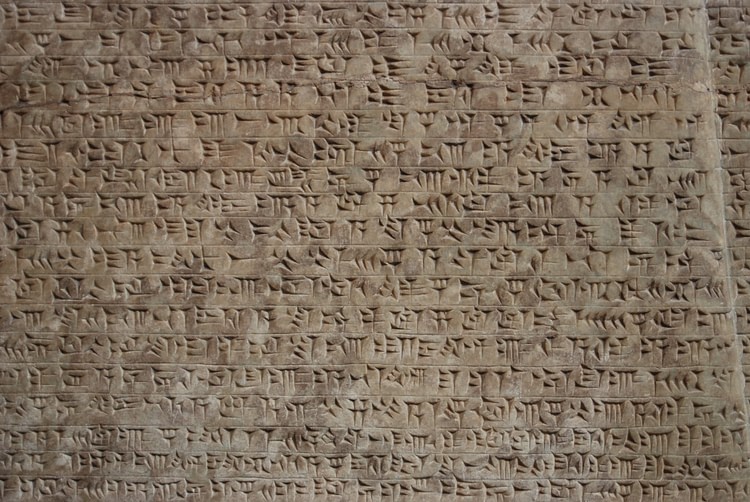Giza › Enheduanna » Ancient origins
Articles and Definitions › Contents
- Giza › Antique Origins
- Enheduanna › Who Was
Ancient civilizations › Historical and archaeological sites
Giza › Antique Origins
Definition and Origins

Giza is a plateau southwest of modern Cairo which served as the necropolis for the royalty of the Old Kingdom of Egypt.Most famous for the pyramids of Khufu (completed in c. 2560 BCE) Khafre (c. 2530 BCE) and Menkaure (c. 2510 BCE) and the Great Sphinx (built 2500 BCE), recent excavations on the plateau have revealed numerous private tomb complexes and workers' quarters. The original necropolis of Giza was laid out with amazing precision and skill but, once it became associated with the great kings of Egypt and their pyramids, attracted the attention of less prominent officials of lower rank. These officials had enough money and prestige to buy their way into burial plots at Giza but had no regard for the symmetry of the original schematics and had their tombs dug wherever they found available space. This resulted in a number of grave complexes throughout Giza which would not have been authorized by the kings who built the famous pyramids which, throughout history, have drawn visitors from around the world.
THE PYRAMIDS OF KHUFU, KHAFRE, AND MENKAURE
Although the Giza plateau is most closely associated with the pyramids of Khufu, Khafre, and Menkaure, the site was used as early as the First Dynasty of Egypt as evidenced by the tomb of the king Djet which was found toward the edge of the plateau. Evidence of at least one king from the Second Dynasty (Nynetjer) buried at Giza has also been found. Further, inscriptions relate how king Khufu had to clear many earlier tombs and grave complexes to build the Great Pyramid. What happened to the corpses or the grave goods from those tombs is not known.
The Great Pyramid of Khufu (also known as the pyramid of Cheops, the king's Greek name) is the last remaining of the ancient Seven Wonders of the World and rises to a height of 481 feet (147 metres). The pyramid of Khafre is 471 feet tall(144 metres) and that of Menkaure rises to 213 feet (65 metres). The Great Sphinx sits on the eastern side of the plateau apart from the pyramids but it is thought it once was an important part of the pyramid complex which covered the area. The head of the Sphinx is believed by Egyptologists to be that of the king Khafre though others contend that represents Khufu. Further on, the great solar barge of Khufu, which is the oldest intact ship extant, was found buried in a pit near the Great Pyramid in 1954 CE.Dating from c.2500 BCE, the ship is 143 feet (43 metres) long and 19 feet (5.9 metres) wide. Near the Pyramid complex there are a number of smaller structures known as the Queens Pyramids. It is uncertain who was buried beneath these pyramids but evidence suggests they were the tombs of Hetepheres I (Khufu's mother), Meretites (Khufu's wife) and a later queen named Henutsen.
THE PYRAMIDS WERE ONCE ENCASED IN POLISHED LIMESTONE WHICH REFLECTED THE LIGHT OF THE SUN BRILLIANTLY.
The pyramids were once encased in polished limestone which, according to ancient writers, reflected the light of the sun brilliantly. The limestone was stripped away over the years for use in other building projects, most notably the mosques of Cairo. Of the three major pyramids, however, only Menkaure's is seen today without any of its original limestone casing;Khafre's Pyramid retains its casing stones at its apex while Khufu's has a smaller remainder at its base. The sides of all three of the Giza pyramids were oriented astronomically to be precisely north-south and east-west within a small fraction of a degree.
OTHER TOMBS
The original layout of the necropolis at Giza seems to have been very precise and well-ordered but, after the end of the Old Kingdom, other tombs were dug without regard for the original pattern. Sometimes they were dug above existing tombs, making present-day Giza a wealth of archaeological material. Recent excavations have uncovered tombs of high officials, magistrates, and supervisors of building projects, as well as monuments honoring the Egyptian workers who labored on the pyramids and others who were employed and lived in the immediate vicinity.

The Pyramids of Giza
THE PYRAMIDS' BUILDERS
No evidence of Hebrew slave-laborers has been discovered at Giza nor anywhere else in the entirety of Egypt, contrary to popular opinion and film-versions of Egyptian history based on the biblical Book of Exodus. In fact, it is well documented that Egyptians were compelled to perform community service for the pharaoh through the construction of monuments, public parks, and tombs. The evolution of the Shabti doll (figurines in the likeness of an individual which were buried with the dead) grew out of this policy of requiring Egyptians to give up a part of their year to work on public building projects.
The only way one could evade this service was by having another take one's place. It was thought, since the afterlife was a mirror image of Egypt, that the great god Osiris would require the same service from the souls in the afterlife. The Shabti doll, blessed with incantations and funerary rites, would come to life in the next world and labor for Osiris in place of the soul of the deceased. Graves and tombs throughout Egypt are easily recognized as belonging to richer or poorer citizens based on the number of Shabti dolls found in them; the more dolls, the richer the person, and the more leisurely their afterlife was supposed to be. The tradition of Hebrew slaves laboring in bondage in Egypt is not not supported by any ancient document other than the Book of Exodus while the practice of skilled Egyptian workers building the pyramids of Giza, and the other monuments throughout the land, is well documented from ancient records and archaeological evidence.
These workers were well fed and taken care of. It is estimated that up to 4,000 pounds of meat from cattle, sheep, and goats was consumed by the workers daily and they had access to the best medical care. These claims are substantiated by the number of animal bones found at the site (over 25,000 sheep bones and 8,000 cattle, among other animals) and the graves of workers whose skeletons show expertly mended bones. These workers also appear to have had dental care and it is thought, based on skeletons found elsewhere, that pyramid workers enjoyed a higher quality of life than they would have in the villages they came from.
ABANDONMENT AND DISCOVERY
During the First Intermediate Period (c. 2181-2040 BCE) Giza was abandoned and fell into decay during the Middle Kingdom (c. 2040-1782 BCE). The tombs, including the pyramids, were broken into and robbed and kings of the Middle Kingdom tore down temples, broke up walkways, and removed statuary for use in their own building projects. The pharaohs of the New Kingdom (1570-1069 BCE) reversed this policy and dedicated themselves to preservation efforts.
Rameses II (1279-1213 BCE) was especially interested in Giza and had a small temple built there in front of the Sphinx. It was Rameses fourth son Khaemweset, however, who worked the hardest to preserve the site. Khaemweset never ruled Egypt but was a crown prince whose efforts to restore the monuments of the past are well documented. In fact, he is considered today the world's "first Egyptologist" for his work in restoration, preservation, and recording of ancient monuments. Khaemweset brought the Giza plateau back to life and it continued to be used as a necropolis by the following dynasties, with less and less frequency, until Egypt was taken over by the Roman Empire in 30 BCE.
The Giza plateau was more or less neglected - except by tourists, those dismantling the structures for their own uses, and grave robbers - until Napolean's Egyptian Campaign of 1798-1801 CE. Napolean had brought along a team of scientists, artists, and engineers who he set to work investigating and recording facts about the Giza monuments and others throughout Egypt. Napolean's work there attracted others to Egypt and archaeologists, adventure-seekers, entrepreneurs, and scholars began traveling to Egypt to investigate these monuments for themselves.
Among the most famous of these was Sir William Matthew Flinders Petrie (1853-1942 CE) whose work is still considered the most important contribution to Egyptology and who brought the Great Pyramid to world attention. It is because of the work of men like Flinders Petrie that on-going preservation, restoration, and archaeological work has continued almost non-stop from the 19th century CE to the present. The Giza plateau is one of the world's most popular tourist attractions and continues to draw visitors from around the world daily.
Enheduanna › Who Was
Definition and Origins

The Akkadian/Sumerian poet Enheduanna (2285-2250 BCE) is the world's first author known by name and was the daughter of Sargon of Akkad ( Sargon the Great, 2334-2279 BCE). Whether Enheduanna was, in fact, a blood relative of Sargon ’s or the title was figurative is not known. It is clear, however, that Sargon placed enormous trust in Enheduanna in elevating her to the position of high priestess of the most important temple in Sumer (in the city of Ur ) and leaving to her the responsibility for melding the Sumerian gods with the Akkadian ones to create the stability his empire needed to thrive.
Further, she is credited with creating the paradigms of poetry, psalms, and prayers used throughout the ancient world which led to the development of the genres recognized in the present day. Scholar Paul Kriwaczek writes:
Her compositions, though only rediscovered in modern times, remained models of petitionary prayer for [centuries]. Through the Babylonians, they influenced and inspired the prayers and psalms of the Hebrew Bibleand the Homeric hymns of Greece. Through them, faint echoes of Enheduanna, the first named literary author in history, can even be heard in the hymnody of the early Christian church. (121)
Her influence during her lifetime was as impressive as her literary legacy. Entrusted by her father with great responsibility, Enheduanna not only exceeded those expectations but changed the entire culture. Through her written works, she altered the very nature of the Mesopotamian gods and the perception the people had of the divine.
LIFE
Enheduanna's name translates as 'High Priestess of An' (the sky god) or 'En-Priestess, wife of the god Nanna '. She came from the northern city of Akkad and, as Kriwaczek notes, "would have had a Semitic birth name [but] on moving to Ur, the very heartland of Sumerian culture, she took a Sumerian official title: Enheduanna - `En' (Chief Priest or Priestess); `hedu' (ornament); `Ana' (of heaven)" (120). She organized and presided over the city's temple complex, the heart of the city, and held her own against an attempted coup by a Sumerian rebel named Lugal-Ane who forced her into exile. The Akkadian Empire, for all the wealth and stability it brought to the region, was constantly plagued by uprisings in the various regions under its control. One of Enheduanna's responsibilities in the region of Sumer would have been to keep the populace in check through religion.
HER HYMNS RE-DEFINED THE GODS FOR THE PEOPLE OF THE AKKADIAN EMPIRE UNDER SARGON'S RULE AND HELPED PROVIDE THE UNDERLYING RELIGIOUS HOMOGENIETY SOUGHT BY THE KING.
In the case of Lugal-Ane, however, she seems to have been bested, at least initially. In her writings, she tells the story of being driven from her post as high priestess and cast into exile. She writes a plea for help to the goddess Inanna requesting her to petition the god An for help:
Funeral offerings were brought, as if I had never lived there.I approached the light, but the light scorched me.I approached the shade, but I was covered with a storm.My honeyed mouth became scummed. Tell An about Lugal-Ane and my fate!May An undo it for me! As soon as you tell An about it, An will release me.
Inanna apparently heard her prayer and, through the gods intercession in her cause, she reports, Enheduanna was finally restored to her rightful place in the temple. She seems to have been the first woman to hold this position in Ur and her comportment as high priestess would have served as an exemplary model for those who followed her.
WORKS
She is best known for her works Inninsagurra, Ninmesarra, and Inninmehusa, which translate as 'The Great-Hearted Mistress', The Exaltation of Inanna', and 'Goddess of the Fearsome Powers', all three powerful hymns to the goddess Inanna (later identified with Ishtar and, still later, Aphrodite ). These hymns re-defined the gods for the people of the Akkadian Empire under Sargon's rule and helped provide the underlying religious homogeniety sought by the king. For over forty years Enheduanna held the office of high priestess, even surviving the attempted coup against her authority by Lugal-Ane.
In addition to her hymns, Enheduanna is remembered for the forty-two poems she wrote reflecting personal frustrations and hopes, religious devotion, her response to war, and feelings about the world she lived in. Her writing is very personal and direct and, as the historian Stephen Bertman notes:
The hymns provide us with the names of the major divinities the Mesopotamians worshipped and tell us where their chief temples were located [but] it is the prayers that teach us about humanity, for in prayers we encounter the hopes and fears of everyday mortal life. (172)
Enheduanna's prayers very clearly express those hopes and fears and do so in a very distinct voice. Paul Kriwaczek paints a picture of the poet at work:
Sitting in her chamber, or perhaps her office, for the director of an enterprise as large and prestigious as the Nanna temple of Ur must surely have been afforded the very best working arrangements, her hair beautifully coiffed by Ilum Palilis [her hairdresser] and staff, dictating to her scribe, perhaps the very Sagadu whose seal Wooley found, Enheduanna proceeded to make her permanent mark on history by composing, in her own name, a series of more than forty extraordinary liturgical works, which were copied and recopied for nearly 2,000 years. (121)
The skill and beauty of these works aside, their impact on Mesopotamian theology was profound. Enheduanna drew the gods closer to the people of the land, synthesizing Sumerian and Akkadian beliefs, to create a richer understanding than either had before. Her reflections on the moon god Nanna, for example, made him a deeper and more sympathetic character and she elevated Inanna from a local deity to the Queen of Heaven. These two deities, and the others she transformed through her work, appeared more compassionate than before; gods for all of the people and not only Sumerians or Akkadians.
DISCOVERY
In 1927, the British archaeologist Sir Leonard Woolley found the now-famous Enhuduanna calcite disc in his excavations at the Sumerian site of Ur. The three inscriptions on the disc identify the four figures depicted: Enheduanna, her Estate Manager Adda, her hair dresser Ilum Palilis, and her scribe Sagadu. The royal inscription on the disc, reads: "Enheduanna, zirru-priestess, wife of the god Nanna, daughter of Sargon, king of the world, in the temple of the goddess Innana.” The figure of Enheduanna is placed prominently on the disc emphasizing her importance in relation to the others and, further, her position of great power and influence on the culture of her time.
Wooley also uncovered the temple complex where the priestesses were buried in a special cemetery. Kriwaczek writes:
Records suggest that offerings continued to be made to these dead priestesses. That one of the most striking artefacts, physical proof of Enheduanna's existence, was found in a layer dateable to many centuries after her lifetime, makes it likely that she in particular was remembered and honoured long after the fall of the dynasty that had appointed her to the management of the temple. (120)
Further proof of her profound impact on culture is that she is still remembered and honoured in the present day and poems are still composed on the model she created over 4,000 years ago.
LICENSE:
Article based on information obtained from these sources:with permission from the Website Ancient History Encyclopedia
Content is available under License Creative Commons: Attribution-NonCommercial-ShareAlike 3.0 Unported. CC-BY-NC-SA License